Tips to Make The Scenes in Your Novel Flow
Capturing the reader at the beginning of each scene and making them want to start the following scene could just lead you to writing a best-selling novel. This is what I mean by make the scenes in your novel flow.
Drawing readers into and out of each scene involves:
- Anchoring each scene
- Having a great entry hook
- Having a great exit hook
Scene Anchoring is the First Step to Make The Scenes in Your Novel Flow
So what does it mean to anchor a scene?
The reader needs to know:
- Who has the point of view?
- Where is the character (location)?
- What’s the timing of the scene?
Point of View
The reader should know who has the point of view within the first paragraph or at least within the first few paragraphs. If not, the reader might find this frustrating. If you write your entire novel from one point of view, like many first-person novels, then you don’t need to worry about this.
Starting a Scene with Dialogue or Thought
If you start a scene with dialogue or thought, check how quickly the reader can tell who else is in the scene. Waiting too long to let the reader know who the character is talking to can be confusing.
Starting a Scene with Description or Action
If you start a scene with description or action, make sure you are describing the scene from the POV character’s eyes.
Setting
You know where the character is because you wrote the scene, but does your reader? If the reader can’t figure out where the character is within the first few paragraphs you may lose them—the reader I mean and not the character. 🙂
There are exceptions to this. If your scene is about a character waking in a dark place and confused about where she is, then it’s okay for the reader to be confused about where she is, too. This will add to the tension. The reader does need to understand the lack of setting is done on purpose.
Timing
The timing of the scene can mean:
- Time of day
- Time passed since last scene
- A particular date
If several years or several seconds have passed in a character’s life, then the reader needs to understand that. If you’re jumping back in time or forward in time, the reader needs to understand that, too. The quicker the reader gets the timing, the quicker they will be drawn into the scene.
Scene Entry Hooks are the Second Step to Make The Scenes in Your Novel Flow
A scene entry hook is the part of your story that will keep the reader reading beyond the first paragraph or two in the scene. The entry hook must happen quickly at the beginning of each scene. You don’t want the reader to read a line or two and put your book down.
How many times have you almost nodded off while reading a book—only to catch the first few lines of the next scene and then decided to keep reading? Whatever you read at the beginning of that scene that grabbed you was the scene entry hook.
When kicking off a new scene, consider:
- Starting in media res (opening in the middle of the action)
- Foreshadowing trouble
- Using a strong line of dialogue
- Raising a question
- Not wasting words on extraneous description
In the novel The Silent Patient, author Alex Michaelides makes great use of scene entry hooks. The Silent Patient won the 2019 Goodreads Choice Awards for best Mystery & Thriller. This tells you many people couldn’t put the book down.
The scene entry hook of chapter one is very strong.
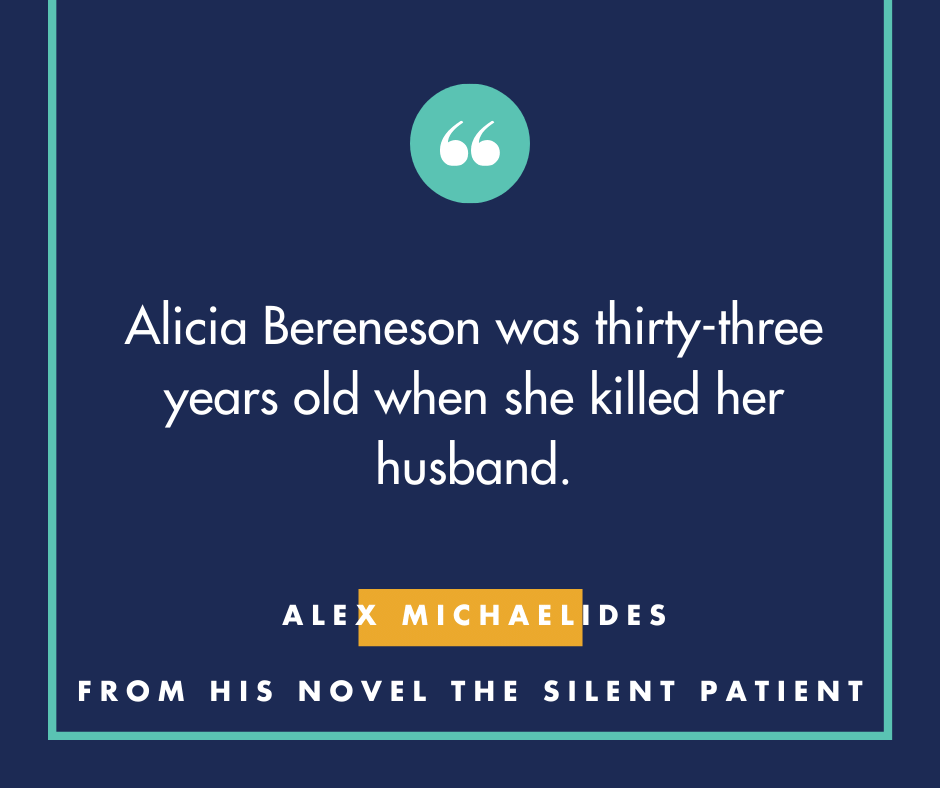
Doesn’t that make you want to read further? Michealides uses strong scene entry hooks throughout the book.
Scene Exit Hooks are the Third Step to Make The Scenes in Your Novel Flow
The exit hook is the magic that keeps your reader wanting to begin the next scene. It’s what will stop them from putting your book down, which means it’s critical for writing a suspenseful and powerful story.
Leave the reader wanting more—and they’ll start the next chapter. A reader should never be left at the end of a scene feeling too satisfied. Never is the important word. As soon as the reader is satisfied, the story is over.
Checking for an exit hook in every scene will help you ensure your client is making the most of the scene ending.
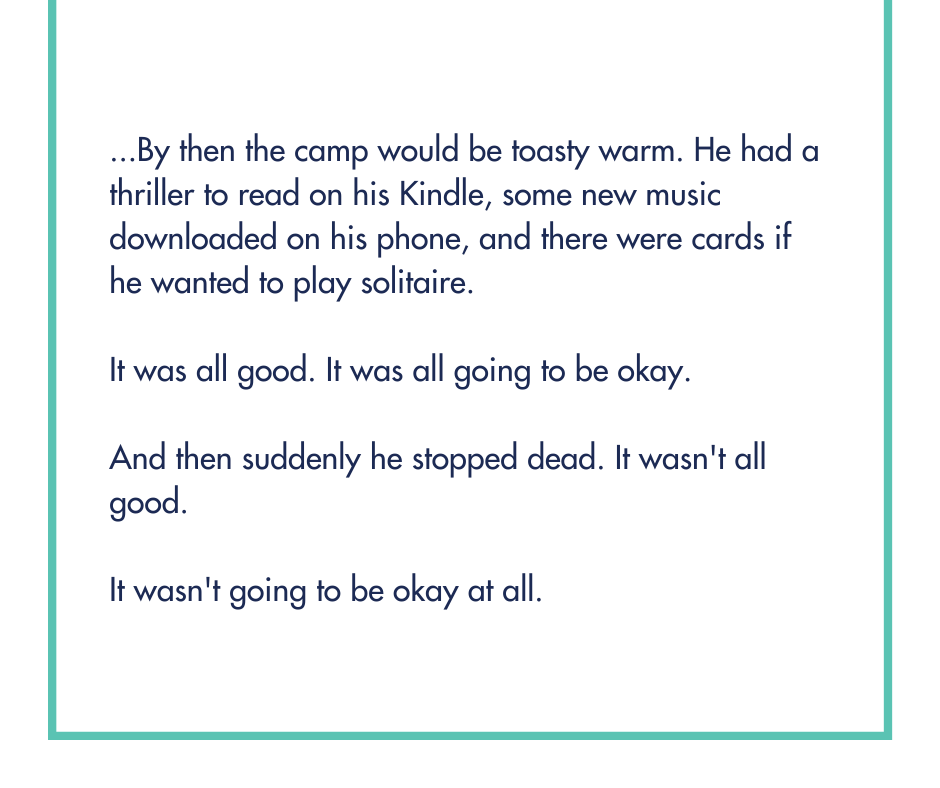 Here is an excellent example of an exit that works. It’s from The Starlight Claim by Tim Wynne-Jones. To set the scene, the protagonist, Nate, is alone and hiking to his remote family cabin.
Here is an excellent example of an exit that works. It’s from The Starlight Claim by Tim Wynne-Jones. To set the scene, the protagonist, Nate, is alone and hiking to his remote family cabin.
Nate is thinking about the day ahead when he’s sees something that frightens him.
The authors leaves the reader wanting to find out what Nate saw.
Note that the authors doesn’t tell us that Nate is frightened, but we know it.
You can see how this element, if used well, will encourage a reader to keep reading.
Here are some common types of exit hooks:
- Dramatic cliffhanger—perhaps your protagonist’s life is at risk
- Revelation—show the reader something that will change the course of the story.
- Setback for the protagonist or antagonist—remember POV goals? Use them here and present your characters with realistic, suspenseful obstacles.
- A secret revealed—you can either reveal a full secret or part of a secret.
- A question left hanging—this will tease the reader, making them crave the answer.
- An unexpected plot twist—to keep the reader guessing!
-
Varying your exit hooks will make your story more interesting for readers. As intriguing as it sounds, ending every single scene with a cliffhanger will get old quickly. Your ultimate aim is to get your reader to resist going to bed, or making dinner, or whatever might take them away from your book, even for a few minutes. Make it impossible for them to stop turning the pages
Example: Make The Scenes in Your Novel Flow
The start of a new scene can mean the point of view has changed, the setting has changed, or time has changed, hence every scene needs to be anchored.
In StoryTeller, use the Anchored story element to keep track that every scene in your novel is anchored. Does the reader know who has the point of view, where the character is, and what time it is?
Anchored: You can see below I’ve checked the POV in my self-evaluation of this scene. By the end of the third paragraph, the reader knows the POV is Jaz Cooper.
I’ve also checked the box for timing. The reader knows the scene is taking place in the early morning hours (paragraph 2).
The scene is taking place in a home on Loughborough Lake (paragraph 3).
If any of these three weren’t set in the opening 3 paragraphs, StoryTeller would be suggesting I consider rewriting the opening of the scene to anchor the reader.

Entry and Exit Hooks
Entry Hook: The entry hook is: “What’s Jaz’s problem?” In the first paragraph, the reader knows Jaz is struggling with an issue. The sentence, “Food wouldn’t solve my problems.” shows the reader Jaz has problems.
Below, you can read the closing of the scene.
Exit Hook: The exit hook is: “Will Jaz drown?” She’s at the side of the hole in the ice, and the reader has to turn the page to find out.
By drawing a reader into a scene with an entry hook and keeping the reader anchored, the reader will want to read the rest of the scene. The exit hook will make your reader want to start the next scene.
Any you guessed it — check the next scene to make sure you have a hook and the reader is anchored. Continue on through your story.
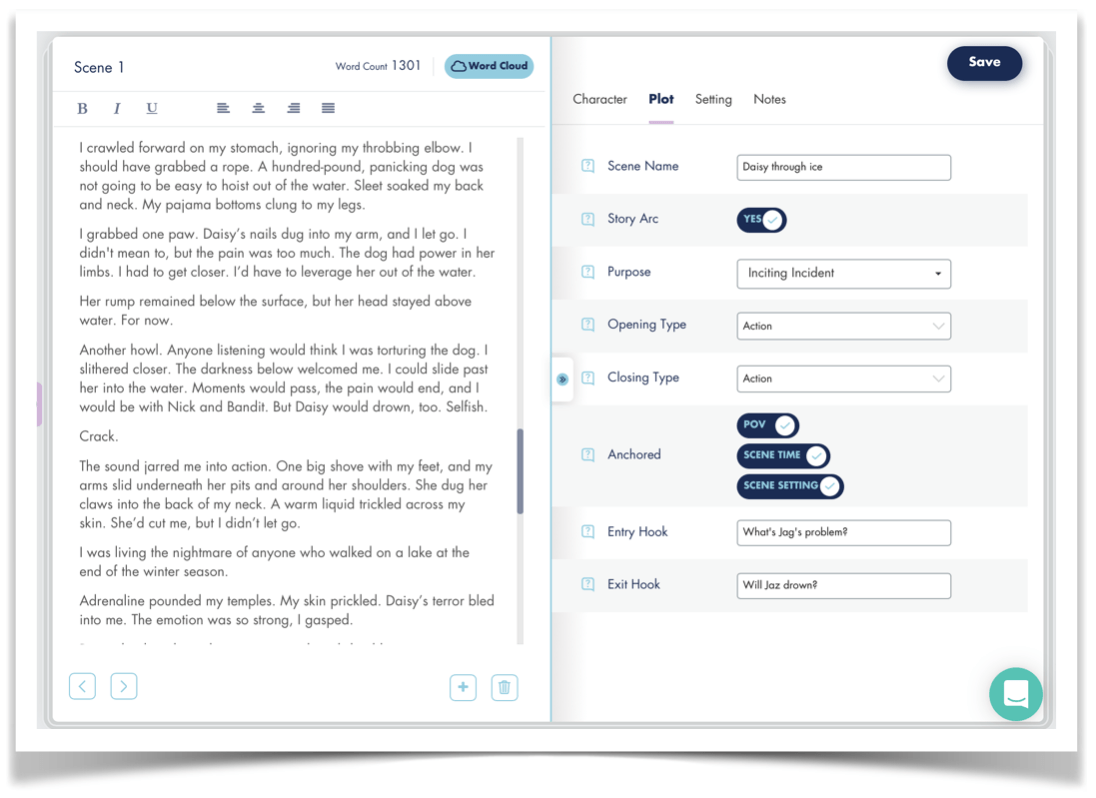
Evaluating Scene Flow in StoryTeller:
Use the Story Map on the Visualize page and select the Scene Name, POV Anchored, Scene Time Anchored, and Scene Setting Anchored.
You select these using the drop-down menu Select Story Map Elements.
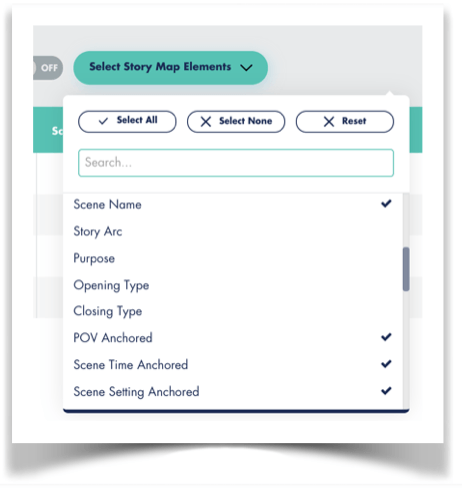
You can see how many scenes have this story element set to No. This guides you on what advice to give your client. This author below has an issue with the Setting not being anchored.
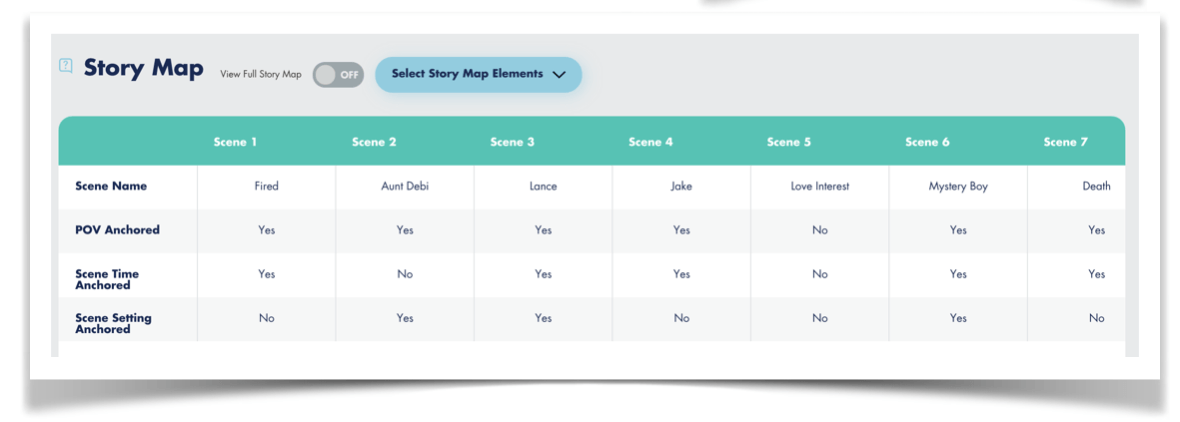
Resources
Choosing a Point of View Character is a Big Decision
5 Ways to Hook Your Reader In Every Scene
6 Ways To Exit A Scene And Keep Your Reader Reading
StoryTeller is creative editing software for fiction writers. Transform your story, not just your words. Successful stories depend on your ability to edit, improve, and revise your work. Only when you master story editing, can you master storytelling.
Why not check out Fictionary’s StoryTeller free 7-day trial and tell powerful stories?

